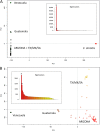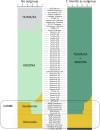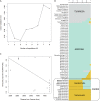Population Structure and Genetic Diversity among Isolates of Coccidioides posadasii in Venezuela and Surrounding Regions
- PMID: 31772050
- PMCID: PMC6879716
- DOI: 10.1128/mBio.01976-19
Population Structure and Genetic Diversity among Isolates of Coccidioides posadasii in Venezuela and Surrounding Regions
Abstract
Coccidioides posadasii is a pathogenic fungus that causes coccidioidomycosis in many arid regions of the Americas. One of these regions is bordered by the Caribbean Sea, and the surrounding landscape may play an important role in the dispersion of C. posadasii across South America through southeastern Mexico, Honduras, Guatemala, and Venezuela. Comparative phylogenomic analyses of C. posadasii reveal that clinical strains from Venezuela are genetically distinct from the North American populations found in (i) Arizona and (ii) Texas, Mexico, and the rest of South America (TX/MX/SA). We find evidence for admixture between the Venezuela and the North American populations of C. posadasii in Central America. Additionally, the proportion of Venezuelan alleles in the admixed population decreases as latitude (and distance from Venezuela) increases. Our results indicate that the population in Venezuela may have been subjected to a recent bottleneck and shows a strong population structure. This analysis provides insight into potential for Coccidioides spp. to invade new regions.IMPORTANCE Valley Fever is a fungal disease caused by two species of fungi: Coccidioides immitis and C. posadasii These fungi are found throughout the arid regions of North and South America; however, our understanding of genetic diversity and disease in South America is limited. In this report, we analyze 10 new genomes of Coccidioides posadasii from regions bordering the Caribbean Sea. We show that these populations are distinct and that isolates from Venezuela are likely a result of a recent bottleneck. These data point to patterns that might be observed when investigating recently established populations.
Keywords: Caribbean; Coccidioides posadasii; Valley Fever; Venezuela; coccidioidomycosis.
Copyright © 2019 Teixeira et al.
Figures




References
Publication types
MeSH terms
Grants and funding
LinkOut - more resources
Full Text Sources
Medical
Molecular Biology Databases
Miscellaneous
